A few days after we arrived back in Darwin, James returned to Seattle for three action-packed weeks back at work. While he was gone, Jennifer got Dirona and Spitfire ready to leave Australia and head out across the Indian Ocean to South Africa. Of the three pleasure-craft marinas in Darwin, we chose Tipperary Waters mainly because it was the only one that would take a reservation several months in advance as we planned the US return trip. We’re very happy with the choice. The setting is beautiful, and the marina is secure and close to downton Darwin.
Highlights from July 14th through Aug 4th follow. Click any image for a larger view, or click the position to view the location on a map. And a live map of our current route and most recent log entries always is available at http://mvdirona.com/maps
 |
Take 2
Position: 130 51.07, -12 26.94
Take 2 entering the locks at Tipperary Waters marina. That sure looks like a tight fit.
|
 |
Darwin My Vet Service
Position: 130 51.07, -12 26.94
Some countries we’ll be visiting over the next year require a health certificate showing proof of continuous rabies vaccinations. Because Australia is rabies-free, rabies vaccine is a controlled substance that requires government approval to bring into the country. Darwin My Vet Service ordered the vaccine for us a few months back and arranged a mobile appointment to give Spitfire a checkup plus the rabies and other vaccinations. Spitfire got a three-year rabies vaccination in Hawaii, and isn’t actually due until January 2016, but we wanted to have the shots done here so he’ll have a respected Australian health certificate.
|
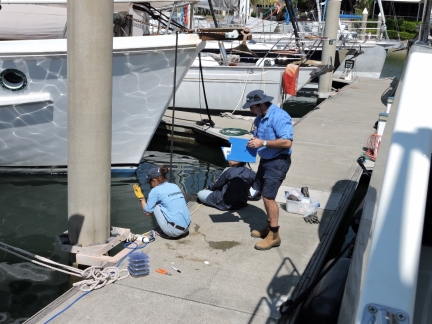 |
Fisheries
Position: 130 51.07, -12 26.94
To prevent the outbreak of aquatic pests, the Northern Territory Department of Fisheries screens all vessels for their biosecurity risk before allowing them into a Darwin marina. Depending on the vessel’s history, a free inspection and/or treatment for marine pests might be required. Here the the Department of Fisheries is performing their monthly marina inspection for possible outbreaks. The small tupperware containers each contain a sponge that was suspended in the water so they can monitor what is growing at different levels. They’ve not had an outbreak for quite some time, but if they do discover one, they’ll dose the whole marina with a copper-based treatment.
|
 |
Woolies
Position: 130 50.42, -12 27.66
A small grocery run to Woolworths. It’s great to be out on the bike again–we haven’t had them down since nearly four months ago on the Gold Coast.
|
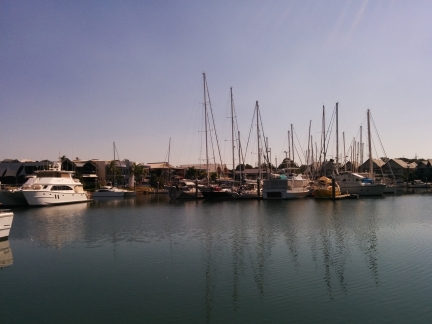 |
Tipperary Waters Marina
Position: 130 51.11, -12 26.96
Looking west across Tipperary Waters Marina from beside the lock. Dirona is at the right of the photo, just behind the yellow boat Tientos, and Superted V is on the left, with the second tallest mast.
|
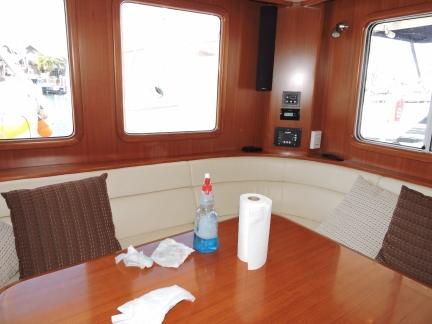 |
Window cleaning
Position: 130 51.07, -12 26.94
Cleaning the windows as part of getting the boat cleaned up and ready for the big run across the Indian Ocean.
|
 |
Cattlest
Position: 130 51.07, -12 26.94
Cattlest (pronounced catalyst) was an even tighter fit into the locks than Take 2.
|
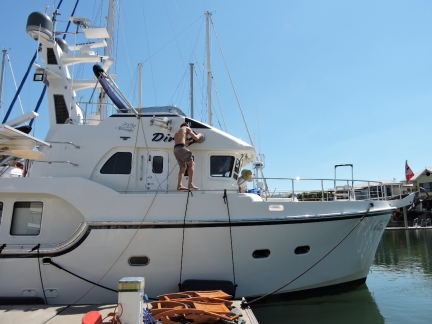 |
Froggies Detailing
Position: 130 51.07, -12 26.94
Our last wax was in the Gold Coast less than five months ago, so we weren’t quite due. But the UV rays here are harsh, and we won’t have another opportunity until much later in the year when we reach South Africa. Froggies is doing a great job and the boat is back to shining again.
|
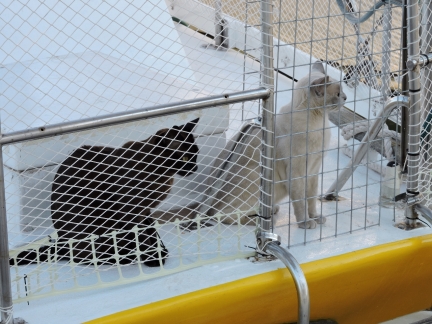 |
Neighbours
Position: 130 51.07, -12 26.94
Keith Pennicott, the Tipperary Waters Marina manager, asked as we arrived if we had any dogs on board. James said no and Keith said “Good. Do you have any cats on board?” “Uh-oh”, James thought as he responded “Yes, we do have a cat on board.” Keith again responded “Good.” Keith and his spouse Lea live on board Tientos across the walkway from ours. Their three cats and Spitfire spend a lot of time eyeing each other.
|
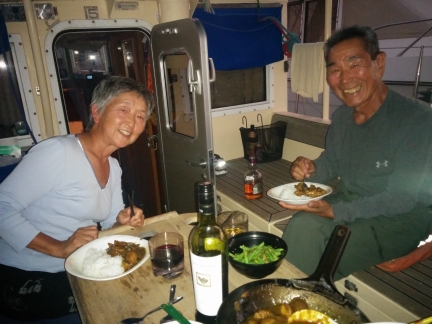 |
Akitsushima III
Position: 130 51.07, -12 26.93
Dinner on Akitsushima III with Norio and Jo-Anne Matsushita. Norio has circumnavigated seven times, and they’ve completed one circumnavigation together. They’ll be heading to Indonesia with the Sail Indonesia rally in a few days. Norio is from Japan, and Jo-Anne is from Richmond, BC near Vancouver. They lived aboard in Vancouver for a number of years and cruised the Puget Sound extensively. It’s surprising to be so far from home and end up moored right beside people from our area. The Pacific Northwest does seem to be a base for a lot of world cruisers.
|
 |
Fuse
Position: 130 50.15, -12 27.57
Jennifer’s first haircut in a year. It had gotten really long–this is after it was cut. Lisa at Fuse did a great job. It’s nice to have the fringe (as they call bangs here) and the ends all even and cleaned up again.
|
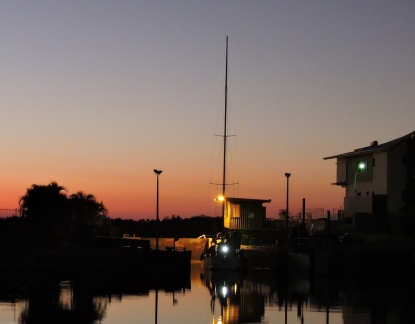 |
Dawn
Position: 130 51.07, -12 26.94
An early-morning departure. Generally only locals can lock through outside daylights hours.
|
 |
Defrosting
Position: 130 51.07, -12 26.94
Defrosting the lazarette freezer and cleaning it before the big trip across the Indian Ocean. The freezer, a Dometic RPF 50, has run without issue since the modifications we made in Fiji.
|
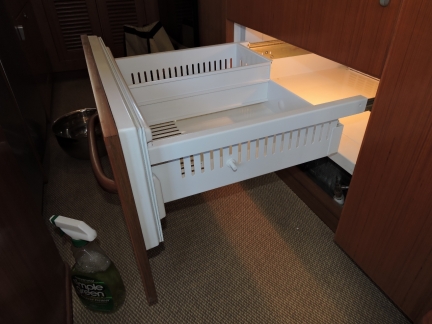 |
Sub-Zero
Position: 130 51.07, -12 26.94
Besides the lazarette freezer, we also cleaned out the Sub Zero. In this photo you can see the design change we made at the yard to replace the teak grill with a teak piece that extends from the bottom freezer drawer to partially cover the equipment. This improves airflow and allows easy cleaning of dust buildup.
|
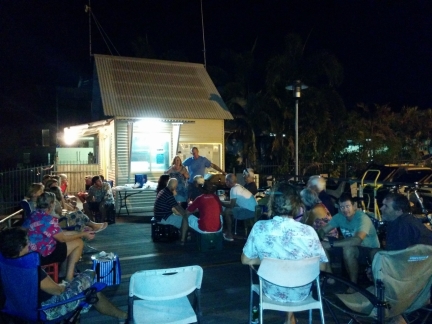 |
Sail Indonesia
Position: 130 51.00, -12 26.91
At the “everyone welcome” Sail Indonesia barbecue. Standing near the marine office giving an orientation are our neighbours Keith Pennicott, the marina manager, and his spouse Lea. They’ve spent much time in Indonesia and will be retiring there next year. Lea has just published a cruising guide on the area.
|
 |
Woolies
Position: 130 51.07, -12 26.94
Stocking up for the big trip–we don’t plan to buy much except fresh produce until we reach South Africa in the October timeframe.
|
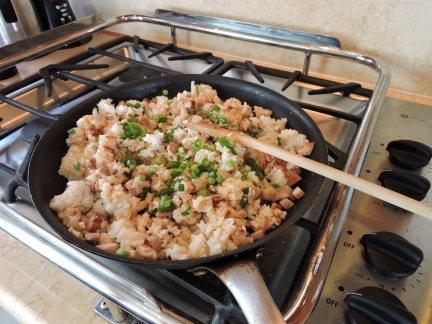 |
Fried rice
Position: 130 51.07, -12 26.94
Making a batch of Teriyaki chicken fried rice to portion and freeze for the Indian Ocean trip. We generally cook regular meals while at sea, but when conditions are rough or we’ve gotten busy with something, it’s nice to have a quick and hearty meal available.
|
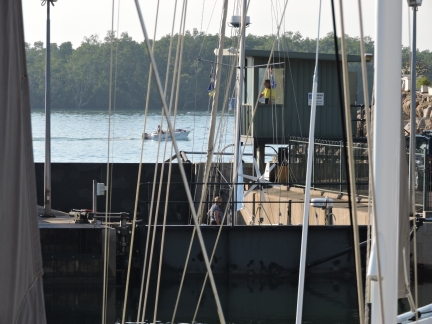 |
Spruce
Position: 130 51.07, -12 26.94
The Sail Indonesia boats are all starting to depart. This is Andy and Sue from Spruce in the lock.
|
 |
Spaghetti sauce
Position: 130 51.07, -12 26.94
And also making a batch of spaghetti sauce to portion and freeze.
|
 |
Akitsushima III
Position: 130 51.07, -12 26.94
Our next-door neighbours Norio and Jo-Anne Matsushita on Akitsushima III also heading out with the Sail Indonesia rally. It already feels kind of lonely here without them beside us.
|
 |
Deckchair Cinema
Position: 130 50.53, -12 28.05
At the Deckchair Cinema in downtown Darwin with Jean and Matt from Superted V. The popular outdoor theatre has nightly screenings and is a bit like a drive-in movie theater, except with deck chairs.
|
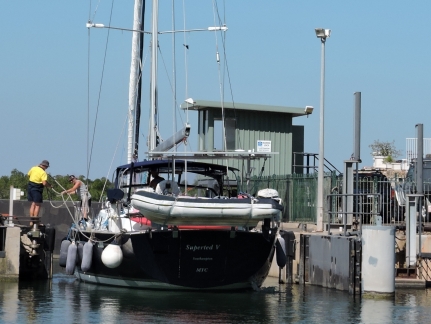 |
Superted V
Position: 130 51.07, -12 26.94
Jean and Matt from Superted V heading out through the lock. This is the last time we will see them for quite a few months–the next time probably won’t be until South Africa. They’ll be spending five weeks in the Kimberley before crossing the Indian Ocean. We’ll be leaving Darwin in a couple of weeks and likely will be ahead of them most of the way across.
|
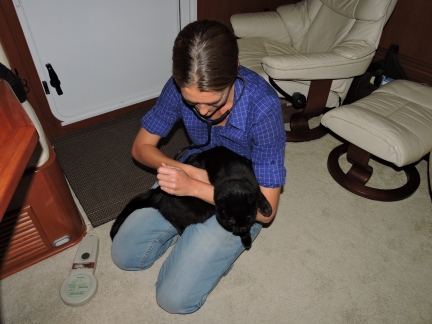 |
Health certificate
Position: 130 51.07, -12 26.94
Caitlin Holley of the Australian Department of Agriculture examining Spitfire for his health certificate. Unlike the US, where the health certificate is generic and just lists vaccination history and test results, the Australian health certificate is tailored to the country of destination. And you must meet all that countries import requirement’s for the health certificate to be issued. Caitlin also endorsed Spitfire’s rabies vaccination certificate. We now have sufficient paperwork to get him all the way to the US eastern seaboard. And finally, Caitlin issued the export certificate required to take any live animal out of Australia.
|
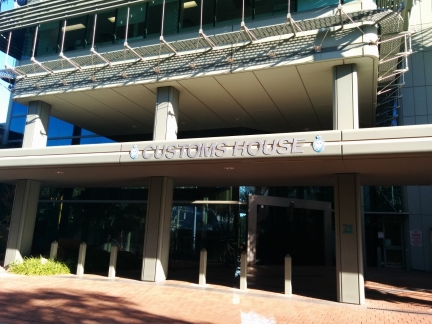 |
Customs
Position: 130 50.43, -12 27.52
At Australia Customs to pickup export paperwork for our temporary imports. With appropriate import paperwork in advance, goods can be brought into Australia duty- and tax-free temporarily for up to a year. The goods we brought in by pallet and on our return trips to the US came in this way. On leaving, export paperwork is required to document that the goods did leave the country. We needed to use a broker for the import paperwork, but did the export paperwork ourselves.
|
 |
Vacuum sealing
Position: 130 51.07, -12 26.94
Vacuum sealing dry goods into storage cannisters to reduce size and better preserve them. For the Indian Ocean run, we’re doing similar preparation as when we left Hawaii. Other than fresh produce, we don’t plan to buy anything between Australia and South Africa, about two months apart. We have a new vacuum-sealer, a FoodSaver V2244. Our previous sealer, a FoodSaver Professional II, eventually died after about 15 years and a couple of “rebuilds”. The new one is more compact, and still is compatible with our storage canisters. We have four canisters and use them to store dry goods such as sugar, salt, flour, rice and pasta. They have been very useful on this trip, particularly in the humid tropics. We also seal some dry and frozen goods in storage bags.
|
 |
Chicken with red peppers
Position: 130 51.07, -12 26.94
Making a batch of stir-fried chicken with dried red peppers to have on hand for the Indian Ocean crossing.
|
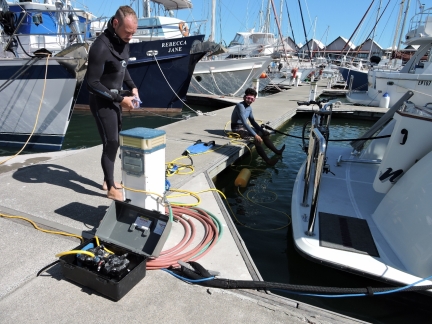 |
Bottom clean
Position: 130 51.07, -12 26.94
With the crocodile threat, we’ve not been able to dive the boat outside the lock since leaving Lizard Island. We don’t like diving the boat in marinas, and won’t have an opportunity before the Indian Ocean crossing. So Froggies Detailing, who waxed the boat earlier, cleaned the bottom as well.
|
 |
Zinc
Position: 130 51.07, -12 26.94
Froggies took a GoPro down with them and sent us some pictures. The bottom looks clean and barnacle-free now. Our zincs were in surprisingly good shape given we’ve not changed them since the New Zealand haulout nearly two years ago, but the main prop zinc was totally missing. Froggies put this new one on for us.
|
 |
Blue moon
Position: 130 51.07, -12 26.94
When two full moons occur in the same calender month, the second is called a blue moon. This happens about once every two years, and we had one last night.
|
 |
Seacret
Position: 130 51.07, -12 26.94
Seacret entering the lock with hardly an inch to spare on either side.
|
 |
Back from Seattle
Position: 130 51.07, -12 26.94
James returned to Dirona today after three action-packed weeks back at work in Seattle. Pictured are some of the parts and supplies he brought back with him, including a new Tilley hat for Jennifer, courtesy flags for the next set of countries we’ll be visiting, a swack of DVDs, and some litter pads for Spitfire.
|

|
Click the travel log icon on the left to see these locations on a map, with the complete log of our cruise.
On the map page, clicking on a camera or text icon will display a picture and/or log entry for that location, and clicking on the smaller icons along the route will display latitude, longitude and other navigation data for that location. And a live map of our current route and most recent log entries always is available at http://mvdirona.com/maps. |
If your comment doesn't show up right away, send us email and we'll dredge it out of the spam filter.

Thanks for the feedback James. I think we are now just about where you are in your thinking except we favor the N60 if we can afford it at the time. But a not-too-distant second would be a Selene 59/60.
Looking back now that you have years (and thousands of hours) cruising time – what (if any) major items did you overspend on? I know it’s a tough question because there may be a piece of equipment that was never used but should it ever have become needed it might have been a life saver, but I am thinking about expensive stuff that now just does not seem that important anymore.
I have a heap more questions but I’ll plug them in over time so I don’t become a nuisance :) Hope you have an safe trip across the Indian ocean. Looks like you will be over the limit of your fuel, even with the two bladders you added from SF yo Hawaii?
Kindest wishes
Etienne
That’s an interesting question Etienne. The boat gets fairly heavy use and, since we boated in the Pacific Northwest for a long time as you have, we had a fairly good idea what we wanted when we worked on this new build.
We tend to use most of the gear we have fairly heavily and we almost never regrest “over engineering.” If we use it and it’s stronger than needed, good! One less failure mode to worry about. The only place where there is room for regret is when we install a component that isn’t strong eough or we don’t use something we installed.
On the haven’t used it enough, their reslly isn’t much. Arguably the window coverings on the pilot house front window don’t ever get used. We just like them open even when in port on in anchorage. I think they are useful for boats that spend time in port not being used but, for our use, we don’t use the front window covers.
The kyaks only get used a couple of times a year but we still like them when we do use them. The FLIR isn’t all that mission critical but it’s an extra data point and, when it comes to spotting ice in the water, it’s incredibly good. If we were doing it again, and could get a good price on the FLIR, we might still install it even though it’s not a vital piece of our nav equipment.
The passeral only gets used a couple of times a year but, when you need them, you really need them. I wouldn’t give it up.
Most of the spares we have on board will never get used but I wouldn’t feel great about not having them when 1,000nm from shore.
The fuel bladders only get used once a year or so but, it’s adds freedom and flexibility so I wouldn’t give them up either.
We’re generally fairly happy with what is installed on the boat. If doing it again, I would start with an electrical design close to what we have today but that’s just a product of us learning and spending time operating the boat in a wide variety of different circumenstances world-wide. It took more experience to find this design.
You asked about the fuel bladders and how we stretch out to 3,000nm without having to go rediculously slowly. We have 2x 300 gallon bladders that fill the cockpit right at the water line so they don’t substantially raise the center of gravity and they are held in fairly well by the cockpit walls so don’t seem at risk of coming free. We also ahve a custom designed 360 gallon bladder that fits in the center of the protuguese bow tight between the PH forward wall and the portuguese bow (it fills the walkway across the center of the boat). It’s is wedged in there so tightly when full that it would not move even if you were able to pick the boat up and turn it upside down :-).
Sorry to have missed saying goodbye and Happy Birthday! Have added you you to my ‘fascinating people’ blogs. May all your bars be wooden and well stocked! Love from the crew of Tientos
Lea, we ended up leaving a day earlier than planned, so didn’t have a chance to say goodbye. Sorry to have missed you too. It was great having you and Keith as neighbours and getting to know you both over the past few weeks, although I think Spitfire is a little relieved to be the only cat around now. We hope everything goes smoothly with your plans to sail off to Indonesia next year. It sure looks beautiful–we’ll have to get there one day. And we’ll look for Tientos when we do.
Thanks for sharing all the photos and details that go into planning your voyages. Hope you have a safe journey through the Indian Ocean. Just wondering about not wanting to use the marina for cleaning. I’m guessing some have nasty waters but surely some are not so bad. Looking forward to reading more about your adventures. Praying for calm waters and safe seas ahead.
Good question Stewart. You are right that some marinas are fairly clean and some are a bit polluted but it’s not really the pollution level that gives us pause. It’s the electrical risk. Large numbers of boats all plugged into shore power, if they are all wired properly, are fairly safe. But, a mis-wired boat or one with faulty electrical equipment can pose an electrocution risk. It’s not super common but, each year, a few die due to electrical faults when swimming near boats that are either plugged in or on the generator.
On this point, we are likely more careful than needed but we chose not to dive the boat if it’s plugged in, near other plugged in boats, or the generator is running.
Hi Jennifer and James,
Anneline and I have been watching your travels over the past years but more so lately for two reasons – you are now heading to our country of birth (SA) and secondly, we have set our minds (or perhaps more accurately, our hearts) on extended cruising in a few years when our land based responsibilities might allow us. So we have a heap of questions and hope you can share your experience with us. First, of course, your choice of vessel – which others did you consider? Did you consider Selene?
And once you settled on Nordhavn, why the N53? Did you look at the N55? We like the N55/60 for it’s single level staterooms and elevated pilot house with attached bunk and head.
Thank you.
Etienne, it’s good hearing from you. We did indeed look at Selene, Krogan, Northern Marine, and some custom designs. Basically we looked at everything that was world capable. The Northern Marines are more boat than we want and the Krogan’s seemed a bit more expensive than Nordhavn and Selene and we generally didn’t like the Krogan layouts quite as much. They are very nice but, for our tastes, we prefered the Nordhavn layout.
In the end, we were looking more closely at the Selene and Nordhavn and making the decision between those two boat lines. The Nordhavn is better equipped, has more ocean crossing experience in the company, and generally gets more of the details right. But the Selene was less expensive and, with less initial cost, you certainly can fix many of the details. But, in the end, the Selene wasn’t enough less expensive to cover the costs of all the changes we would make. The Nordhavn starts off closer to the boat we wanted and is pretty good value so it won out over the less expensive Selene. We prefered the Nordhavn and, by the time we equipped the Selene the way we wanted it, the price advantage wasn’t enough to get us excited.
Having spent thoursands of hours in the Nordhavn and learned a lot more since we made that original purchase decision, we are glad we ended up where we did. The boat has many advantages of which we were not aware at purchase time, the Nordhavn owners community is super helpful, and PAE is always available even though our purchase was 6 years ago and thousands of hours in the past.
Why not a 55 or a 60? Good question. Dollar to area, the 60 is probably a better deal. But, in absolute dollars it was more money the the N52. We wanted to go with the smallest boat that could do what we wanted to ensure that we unexpected repairs wouldn’t be a huge economic burden and that we had the funds left to really enjoy the boat. The 52 just felt like it woudl do the trick and it certainly has. We slightly prefer the lines of the N52 to those of the N55 and the N60 wasn’t available when we made the decision to buy Dirona. Were we to do another build today, we probably would go with a Nordhavn 60 but, even now, we would have to think very hard about which of the 52 or 60 to get. They are both excellent boats.
Overall, no regrets. In fact, I just love that we are typing this on a sat link from the Kimberley region in North Western Australia. It’s been a heck of an adventure so far.
I like all your supplies from Seattle. I spent a bit of time there years ago and loved it. We love our Tilley hats as well. Keep an eye out for pieces of aircraft on your way across the Indian Ocean.
It was good being back in Seattle and, we agree, it is a very livable city. I’m not back nearly frequently enough so it’s super busy when I’m there so, in some ways, it’s nice to be back in Darwin.
We have been seeing the reports of aircraft debris washing up on the beaches of Reunion. No related problems expected on the crossing — the weather is a bigger concern for us when out for 3 weeks at a time — but we will keep a sharp lookout. Thanks Brett.
Hi Jennifer, I’ve been watching your travels through the blog with interest. My wife and I would love to go cruising one day and I have flown over all the Australian areas you have been recently when I used to work for Coastwatch. I was wondering if you are planning to visit Christmas and or Cocos island on your way across the Indian Ocean? Christmas is not such a good anchorage but Cocos is and both beautiful places,
Cheers
Brett
Brett, we have spoken to a good many of your colleagues over the past year, as we’ve enjoyed the Reef and Kimberley areas. For this crossing, we’re planning to head directly across from Dampier to Rodrigues.
Great planning. Have a great trip and stay safe.
Thanks Filo. Sorry I missed you in not returning back to the US this trip.